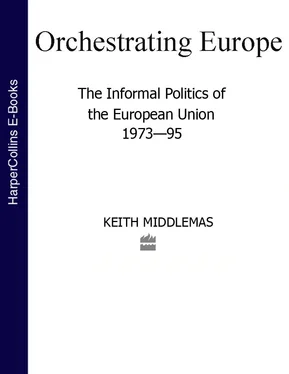Its success, however, was more than a question of personnel. At an organizational level, the Commission was quickly able to establish its own priorities and, still more importantly, to implement them. This, in turn, was facilitated by the compactness of the Commission itself, as evidenced by its small number of portfolios. Only later, when the EEC was merged with the ECSC and EURATOM, did its focus become blurred; it was then further diluted by the addition of new commissioners to satisfy new members in 1973. It is also undeniable that political factors played an important part. Early support from the Americans had certainly helped to increase the legitimacy of the new organization. Additionally, foreign policy challenges, an area in which the Rome treaties had given the commission an important role, presented themselves in the form of GATT trade rounds and in preparing the response to UK initiatives. Finally, the favourable economic climate provided new opportunities in the shape of an accelerated creation of the common market and thus created new areas for the Commission to exercise its influence at an early stage.
I once asked a senior official with a lifetime of service in the Commission, what the difference was between an inter-governmental organization, with a large and efficient secretariat, and a supranational community, controlled by a Council of Ministers (often voting with unanimity) and a large and efficient Commission. He replied that often there was no discernible difference, especially if there were sources of disunity within the group. However, if the political or economic constellation were favourable, a supranational community could respond more quickly and effectively to issues to which an inter-governmental agency might not be able to respond at all. He argued that the first Hallstein Commission was fortunate to find itself in such a situation. 11Small, uncertain, and untried, the new Community soon found itself basking in a golden age, and inspiring a whole branch of theorizing among political scientists into the bargain.
The Six’s first step in economic integration was the building of a customs union for industrial goods. All tariffs and quotas on trade between members were to be reduced gradually to zero and a Common External Tariff (CET) installed. The first 10 per cent tariff cut on intra-EEC trade took place in January 1959 and, according to schedule, bilateral quotas were multilateralized, while those quotas that were extremely restrictive (less than 3% of output) were expanded. At the same time, the benefits of the tariff cuts (other than those on tariffs already below the planned CET) were extended unilaterally to other GATT members. This was partly to anticipate criticism in the GATT that the EEC would develop into a closed organization and partly to cool the row that had erupted after the failure of the free trade area negotiations, which would have been aggravated had the Six immediately begun tariff discrimination against the rest of Europe.
The next two tariff cuts of 10% each were to take place in July 1960 and December 1961. Hallstein suggested accelerating the schedule, ostensibly to take advantage of the favourable economic climate but also to accentuate the EEC’s own identity at a time when there was still an active interest in subsuming its commercial arrangements into a wider European grouping. As a result, in May 1960 the Council of Ministers decided to proceed, on schedule, with the July reduction but to make the next cut a year early, in December 1960. Similarly, in May 1962, the Council decided that the state of the economy allowed the 10% cut scheduled for July 1963 to be brought forward a year. Due to these accelerations, tariffs between the EC members were dismantled completely by July 1968, two years ahead of schedule. 12
The creation of a customs union by the Six also implied a common level of tariff protection towards the outside world. This too was completed ahead of time. The first problem was to define the tariff itself. The CET should have been calculated as the unweighted average of tariffs in four areas, but for a number of products (mostly in the semi-manufactured and petro-chemical sectors) this formula was opposed. Due to lack of time in the Treaty of Rome negotiations, these goods had been consigned to List G and left to be decided by January 1962. Because of the need for a complete tariff schedule before entering GATT negotiations, this operation was completed by March 1960 and the outcome, moreover, was far less protectionist than had originally been anticipated. 13Because the timetable of internal tariff cuts had been accelerated, so too was the realignment of national tariffs. In January 1961 and July 1963, the margin between national and projected rates was reduced by 30% each time, and the gap was finally closed in July 1968.
Although the Commission boasted that the level of the CET was moderate and its incidence considerably narrower than the British tariffs, Paxton stresses that ‘in practice, the common external tariff as originally fixed was higher and more restrictive than the average incidence of the 1957 tariffs.’ Germany had already in the mid–50s been concerned that their first post-War tariff had been fixed at too high a level and had already engaged in some unilateral reductions of their own. The Dutch too had been alarmed at the upward revision of tariffs on semi-manufactured goods especially. Neither country had been happy with the upward drift in protection that the CET implied. They therefore welcomed the call in 1958 by US under-secretary of state, Douglas Dillon, for a new multilateral tariff round in GATT. So too did the Commission. The Treaty of Rome had constituted a single bloc from four, already large, trading entities. Under GATT rules which applied to negotiations between major suppliers, this enhanced its importance and its international recognition, especially in relations with the United States. Moreover, since the Treaty also allocated the Commission a specific role in preparing and negotiating foreign commercial policy, the Dillon Round immediately promised it a prominent role in the national policies of the Six. 14
The Dillon Round was delayed by the need firstly to construct the CET and then to get it approved by the GATT. Once underway, the Commission suggested a 20% ‘linear’ reduction in the CET, subject to reciprocal concessions by other countries. This idea foundered on the inability of the US to react to an offer framed in this way, but it is far from certain whether it would have been endorsed by the Six anyway. Thus the negotiations proceeded bilaterally on a product-by-product basis. No less than 4400 bilateral deals were made covering trade worth $4.9 billion and resulting in tariff cuts of about 7%. This outcome, however measured, was twice a good as that of the previous ‘round’ in Geneva in 1956 but was still considered disappointing. However the Dillon Round did have one important side-effect in that it convinced the Kennedy administration, in framing the 1962 Trade Expansion Act, not only to reopen tariff negotiations but to empower the US to negotiate across-the-board tariff cuts.
The Kennedy Round lasted from May 1963 to June 1967 and resulted in the largest tariff cuts in modern history, although the across-the-board method was not employed, since the EEC argued that the disparity in US tariffs, compared with those in Europe, would lead to inequitable results should that method be used. Nonetheless, over 8000 deals were made with a trade coverage of $40 billion and an average reduction of 35%. In over two thirds of cases, with the steel and chemical sectors especially heavily represented, tariffs were reduced by more than half. Textiles, on the other hand, recorded only minor gains. Equally, little progress was made in grains, meats and dairy produce which were rapidly being embraced by the Common Agricultural Policy (CAP) and where the French, especially, were reluctant to make concessions. The need to conclude the CAP, and the ‘crisis’ that had accompanied it, served to delay progress. More importantly, it prevented the tradeoffs that might have made deeper cuts possible elsewhere. Nonetheless, despite the tensions that inevitably accompanied the process of establishing a single position, the Commission emerged from the exercise with its international status considerably enhanced.
Читать дальше









![Brian Thompson - A Monkey Among Crocodiles - The Life, Loves and Lawsuits of Mrs Georgina Weldon – a disastrous Victorian [Text only]](/books/704922/brian-thompson-a-monkey-among-crocodiles-the-life-thumb.webp)


